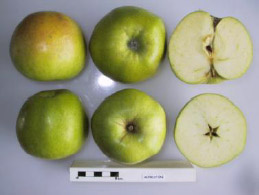
History of the Alfriston apple
Raised in the late 1700s by Mr Shepherd of Uckfield and originally named Shepherd’s Pippin. It was renamed Alfristonin 1819 by Mr Booker who lived in that village. It received an RHS Award of Merit in 1920.
Currently cultivated as part of Brighton Permaculture Trust’s National Collection in Stanmer Park, Brighton.
Description of fruit
The Alfriston apple is medium to large in size and bright green or greenish yellow with conspicuous white dots (lenticels) on the skin of the fruit.
Its shape is oblong with a flat base and rounded apex. Basin broad, deep. Ribbed. Eye large, partly open. Sepals broad base. Cavity quite broad, quite deep, russet lined. Stalk short & thick.
Alfriston is quite a sharp cooking apple that cooks to a lightly flavoured puree and is very good baked.
“It was much recommended and planted in the last century, when it proved to be one of the best culinary apples of the time. Now it is superseded by varieties more regular in outline and more handsome to the eye, though none is better for cooking,” wrote HV Taylor in 1948.
Season of use
Fruit can be picked in early October. It stores well and can keep till April.
Tree habit
The tree is moderately vigorous.
Flowering and pollination
Flowering day: F10 Biennial
How to identify an Alfriston apple
Apples can be identified by sending them to the National Fruit Collection at Brogdale or by bringing a sample to Apple Day Brighton, where an expert pomologist will be on hand to identify apples. From each tree, bring three or more ripe fruits and a shoot with representative leaves.
Where to buy an Alfriston apple tree
Please contact us for details of our supplier for Sussex apple varieties.